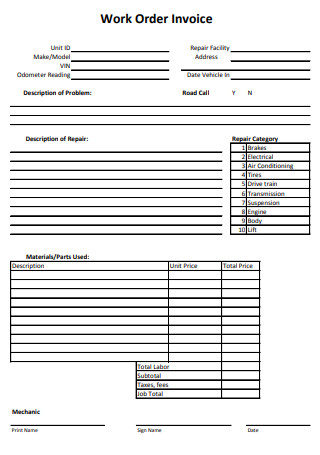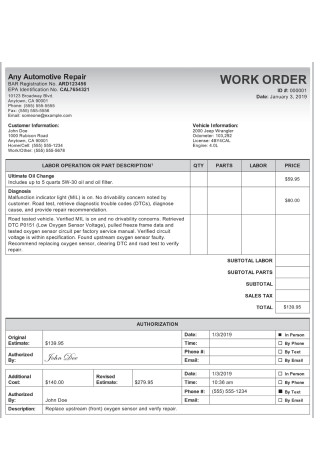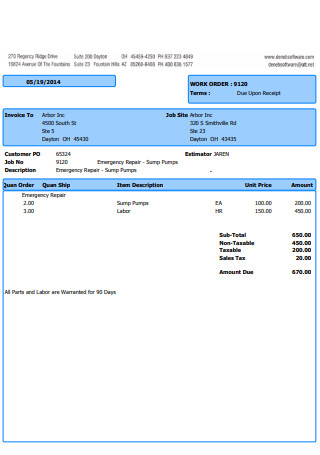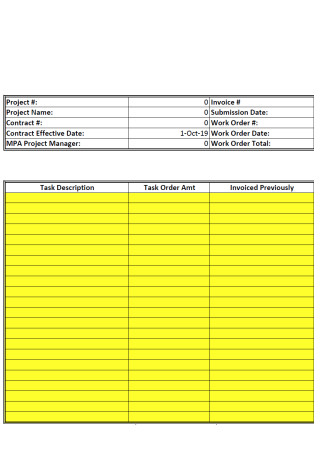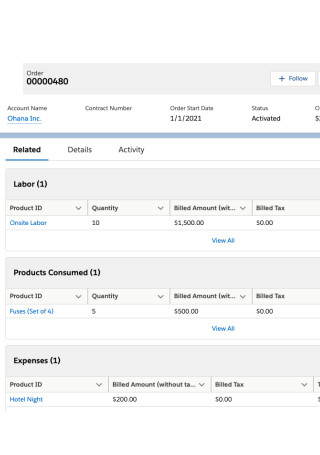4+ SAMPLE Work Order Invoice
FREE Work Order Invoice s to Download
4+ SAMPLE Work Order Invoice
What Is a Work Order Invoice?
Elements of a Work Order Invoice
Steps in Writing a Work Order Invoice
FAQs
In what ways are work orders and purchase orders distinct from one another?
What are the different types of work orders?
Is an invoice considered a legal document?
What Is a Work Order Invoice?
A work order is a written request form that a customer submits to a business in order to obtain certain items or services from the company. Most work order forms include information such as the work order number, customer billing, and shipping addresses, the customer’s name, the requested date, the expected delivery date, the details of the item or service, the payment terms, the delivery method (if applicable), the unit price, the subtotal, the total cost, and an authorized signature on the form. Generally speaking, an invoice is simply a bill that is sent from one party to another, seeking payment for products sold or services rendered. Even though you may refer to an invoice as a sales invoice, the individual making the purchase may refer to it as a purchase invoice.
Other templates are available on our website, and you can use them whenever you need them. They are as follows: customer invoice, bid proposal, security bid proposal, bakery invoice, electrical invoice, club strategic plan, quality control contract, Work Order Form, sports invoice, Work Order Agreement, and other similar templates are available. This post will not only provide you with templates but will also provide you with important information that you need to know in order to complete your template.
Elements of a Work Order Invoice
Client-generated work orders can take on a number of shapes and sizes depending on the industry in which the client is employed. It is crucial to note that, despite the fact that they may differ in terms of the type of work, the cost, and the resources available, they all follow the same cycle of development from the start to the finish. A few instances of frequently encountered work orders are as follows:
Steps in Writing a Work Order Invoice
Once you have a rough idea of the many types of work orders that are accessible, it is time to create a work order specifically for your company’s requirements. Service providers and contractors both create work orders for invoice purposes, but they do so in a somewhat different ways. In most cases, generating a work order invoice is not difficult because it is identical to any other sort of standard contract. Knowing the core components of a work order would be advantageous in this situation. We offer pre-existing work order templates accessible for download on our website, which you can use as a reference when creating your own work order templates. In spite of this, the following are some of the most critical processes in creating an invoice work order:
Step 1: Determine and Describe the Nature of the Problem
Identify and document the specific problem that needs to be addressed and fixed as quickly as feasible. Make a note of the date and time when the issue first occurred. Specify when the equipment, machinery, or vehicle was last submitted to maintenance and what the results were. In this section, you can keep track of actions that are expected or necessary to be completed, services that have been performed in the past or present, and any other procedures that are required to complete the task at hand. Provide as much particular information as you can about the industry in which you would be working, as well as about your qualifications. In addition, you should review our Contractor Safety Plan.
Step 2: Work Instructions and Assignment Specifics Should be Written Down.
In addition to laying out the specifics of the job to be accomplished, provide any additional instructions or modifications that may be necessary. Because a work order assignment is created by the service provider or the contractor, it is critical to include the name of the party or individual who has requested the service in the work order assignment as part of the service request. You should provide the following information: the name, address, phone number, and location of the facility where the work is expected to be conducted for the client. In addition, make a note of the date and time at which the request was submitted. In addition, you should review our payment invoice
Step 3: Establish the Turnaround Time for the Work as well as the Priority Level for the Work.
Prepare a schedule for the duration of your task, including the dates on which you intend to begin and the dates on which you expect to complete it. Determine whether the work is of low, medium, or high priority by placing it in the appropriate category. In order to keep track of the progress of the project, assign a work order number to each item on the list. In addition, you should review our event planner invoice.
Step 4: It Is Necessary to Determine the Labor, Tool, and Cost Requirements.
A detailed description of the work to be completed should be included in this section. Make a note of the name of the individual who has been assigned to conduct the labor or offer the service if it is necessary. In the event that you’re performing maintenance and repair work, establish a list of any parts or materials that need to be replaced, along with an estimate for the cost of procuring replacements. Identify the number of goods to be installed as well as any raw materials or tools that will be required during the installation process if it is the installation of a new product. Don’t forget to factor in the cost of labor as well. These particulars will be used in the future for the purposes of invoicing and payment.
Step 5: Approval of the Final Product
After confirming that the client is in agreement with everything on the work order agreement, collect his or her signature on the paper and forward it to the party or individual who will be performing the labor or providing the service that was agreed upon by the parties.
FAQs
In what ways are work orders and purchase orders distinct from one another?
Work orders are primarily concerned with labor details, whereas purchase orders are concerned with things that are currently on sale.
What are the different types of work orders?
Work orders are classified into two categories: bids and orders. The quotes contain a list of the products that a client intends to purchase as well as the pricing of the things that the customer is expected to pay. All that is recorded in the orders is a list of things that buyers are likely to purchase.
Is an invoice considered a legal document?
An invoice is not a legal document in and of itself. It is not a legally enforceable contract between a corporation and its customer or client.
Once you’ve finished creating the invoice, double-check it to see if there are any problems or incorrect information being entered into the system. Consult with a colleague to ensure that you have prepared the invoice correctly, that it is pleasant and orderly, and that there are no spelling or grammatical issues on the invoice. You may use our free example invoice templates to take you through the process of creating a work order invoice. Download our free sample invoice templates above to get started!

